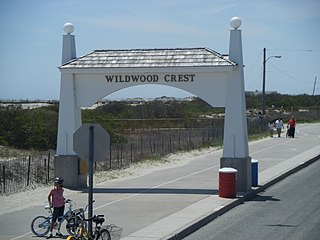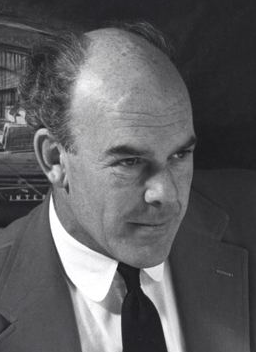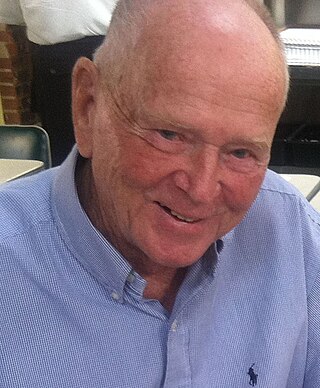
Wildwood is a city in Cape May County in the U.S. state of New Jersey. The city, and all of Cape May County, is part of the Ocean City metropolitan statistical area, and is part of the Philadelphia-Wilmington-Camden, PA-NJ-DE-MD combined statistical area, also known as the Delaware Valley or Philadelphia metropolitan area. As of the 2020 United States census, the city's year-round population was 5,157, a decrease of 168 (−3.2%) from the 2010 census count of 5,325, which in turn reflected a decline of 111 (−2.0%) from the 5,436 counted in the 2000 census. A popular Jersey Shore resort destination, the population can swell to 250,000 during the summer. Wildwood was the first city in New Jersey to have a female mayor, Doris W. Bradway, who was ousted in a 1938 recall election.

Wildwood Crest is a borough in Cape May County, in the U.S. state of New Jersey. The borough, and all of Cape May County, is part of the Ocean City metropolitan statistical area, and is part of the Philadelphia-Wilmington-Camden, PA-NJ-DE-MD combined statistical area, also known as the Delaware Valley or Philadelphia metropolitan area. As of the 2020 United States census, the borough's population was 3,101, a decrease of 169 (−5.2%) from the 2010 census count of 3,270, which in turn reflected a decline of 710 (−17.8%) from the 3,980 counted in the 2000 census.

Googie architecture is a type of futurist architecture influenced by car culture, jets, the Atomic Age and the Space Age. It originated in Southern California from the Streamline Moderne architecture of the 1930s, and was popular in the United States from roughly 1945 to the early 1970s.

The Jersey Shore is the coastal region of the U.S. state of New Jersey. Geographically, the term encompasses about 141 miles (227 km) of oceanfront bordering the Atlantic Ocean, from Perth Amboy in the north to Cape May Point in the south. The region includes Middlesex, Monmouth, Ocean, Atlantic, and Cape May counties, which are in the central and southern parts of the state. Located in the center of the Northeast Megalopolis, the northern half of the shore region is part of the New York metropolitan area, while the southern half of the shore region is part of the Philadelphia metropolitan area, also known as the Delaware Valley. The Jersey Shore hosts the highest concentration of oceanside boardwalks in the United States.

John Edward Lautner was an American architect. Following an apprenticeship in the mid-1930s with the Taliesin Fellowship led by Frank Lloyd Wright, Lautner opened his own practice in 1938, where he worked for the remainder of his career. Lautner practiced primarily in California, and the majority of his works were residential. Lautner is perhaps best remembered for his contribution to the development of the Googie style, as well as for several Atomic Age houses he designed in the late 1950s and early 1960s, which include the Leonard Malin House, Paul Sheats House, and Russ Garcia House.

The Wildwoods are a group of five communities in Cape May County, New Jersey. These are situated on the Island of Five Mile Beach, a barrier island facing the Atlantic Ocean. These Jersey Shore communities have relatively small year-round populations that swell significantly during the summer with vacationers.
Alan Hess is an American architect, author, lecturer and advocate for twentieth-century architectural preservation.

Pann's is a coffee shop restaurant in the Westchester neighborhood of Los Angeles, California, known for its history, role in movies, and distinctive architecture. The restaurant was opened by husband and wife George and Rena Poulos in 1958. It is also known for its neon sign, Googie architecture, and 1950s decor. The building and its iconic neon sign were designed by architects Eldon Davis and Helen Liu Fong of the Armet & Davis architectural firm. Pann's remains one of the best preserved examples of Davis' Googie designs, according to the Los Angeles Times.
Armet Davis Newlove Architects, formerly Armét & Davis, is a Californian architectural firm known for working in the Googie architecture style that marks many distinctive coffee shops and eateries in Southern California. The firm designed Pann's, the first Norms Restaurants location, the Holiday Bowl and many other iconic locations.

The Holiday Bowl was a bowling alley on Crenshaw Boulevard in Los Angeles, California. It was founded in 1958 by five Japanese-Americans and was a significant part of the rebuilding process of the Nikkei community after internment during World War II. The owners of the Holiday Bowl sold shares throughout the community to finance its construction."

Wich Stand was a '50s-style coffee shop restaurant and diner in Los Angeles, California, featuring a tilting blue roof and 35-foot spire (11 m), designed by architect Eldon Davis.

Johnie's Coffee Shop is a former coffee shop and a well-known example of Googie architecture located on the corner of Wilshire Boulevard and Fairfax Avenue in Los Angeles, California. Architects Louis Armét and Eldon Davis of Armét & Davis designed the building, contributing to their reputation as the premier designers of Space Age or Googie coffee shops—including the landmark Pann's coffee shop in Ladera Heights, Norms Restaurant on La Cienega Boulevard, and several Bob's Big Boy restaurants.

The Wildwoods Shore Resort Historic District, or Doo Wop Motel District, is an area in The Wildwoods, New Jersey, that was home to over 300 motels built during the Doo-Wop era of the 1950s and 1960s. Officially recognized as a historic district by the State of New Jersey, it lies primarily in the municipality of Wildwood Crest, along a two-mile stretch between Atlantic and Ocean avenues, and includes areas in Wildwood and North Wildwood. The term doo-wop was coined by Cape May's Mid-Atlantic Center for the Arts in the early 1990s to describe the unique, space-age architectural style, which is also referred to as the Googie or populuxe style.

The Caribbean Motel is a historic motel located in Wildwood Crest, New Jersey. It is located in the Wildwoods Shore Resort Historic District. The motel was built in 1957 in the Doo-Wop style by Lou Morey, whose family built many of the Wildwoods' original Doo Wop motels, for original owners Dominic and Julie Rossi. It was owned by the Rossi family until the early 1990s, when they sold it to multi-billionaire Mister Bolero.

Chateau Bleu Motel is located in North Wildwood, Cape May County, New Jersey, United States, in an area now known as, and designated by the state of New Jersey as, the Wildwoods Shore Resort Historic District. The building was built in 1962 in the distinctive "Googie" or "Doo Wop" architectural style. Googie details include the heart shaped swimming pool and the spikes at the entrance. The motel was added to the National Register of Historic Places on March 25, 2004.

Eldon Carlyle Davis was an American architect, considered largely responsible for the creation of Googie architecture, a form of modern architecture originating in Southern California. Googie architecture is largely influenced by Southern California's car culture and the Space Age of the mid-20th century. Davis was a founding partner of the Armet & Davis architectural firm which championed Googie architecture, including the original Norms Restaurant, a Googie coffee shop designed by Davis. For his work, the Los Angeles Times called Davis, "the father of the California coffee shop."
Louis Logue Armét was an American architect and strong proponent of Googie architecture during the mid-twentieth century.

Jack Laxer (1927–2018) was an American photographer best known for his work in stereoscopy. His photographs of California modern architecture have been published in magazines and books, displayed in museums, and included in educational programs since the 1950s. He photographed the homes of Lucille Ball and Harold Lloyd with the Stereo Realist camera. His clients included the architects Paul Revere Williams, William F. Cody, Arthur Froehlich, Ladd & Kelsey, and Armet & Davis, best known for their Googie coffee shops. Beginning in 1951 he documented the designs of Louis Armet and Eldon Davis including Norms, Pann's, and the Holiday Bowl. These images were included in Alan Hess's book Googie: Fifties Coffee Shop Architecture, setting off a revival of interest in the style beginning in the 1980s.
Googie's Coffee Shop was a small restaurant located at 8100 Sunset Boulevard in Los Angeles next door to the famous Schwab's Pharmacy at the beginning of the Sunset Strip. It was designed in 1949 by architect John Lautner and lent its name to Googie architecture, a genre of modernist design in the 1950s and 60s. Interest in the style was revived by the 1986 book Googie: Fifties Coffee Shop Architecture by Alan Hess.





























